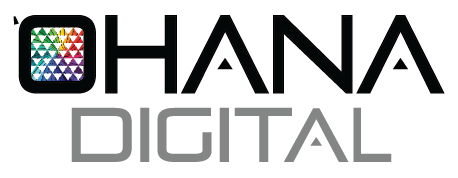In today’s data-driven world, the ability to analyze and visualize data effectively is paramount for making informed business decisions. At Ohana Digital, we understand the importance of leveraging the right tools to transform raw data into actionable insights. One such powerful tool is Google Data Studio, a free, user-friendly platform that enables businesses to create comprehensive custom reports. In this blog post, we’ll explore how Google Data Studio can revolutionize your reporting process and help you unlock the full potential of your data.
What is Google Data Studio?
Google Data Studio is a free data visualization and reporting tool that integrates seamlessly with various Google products and other data sources. It allows users to create interactive, shareable dashboards and reports that provide real-time insights into their business performance. Whether you’re tracking website traffic, social media engagement, or marketing campaign effectiveness, Google Data Studio offers the flexibility and functionality to present your data in a clear and visually appealing manner.
Benefits of Using Google Data Studio for Custom Reports
1. Real-Time Data Visualization
One of the standout features of Google Data Studio is its ability to provide real-time data visualization. Unlike traditional reporting methods that can be time-consuming and outdated by the time they’re shared, Data Studio ensures that your reports reflect the most current data available. This immediacy allows businesses to respond swiftly to changing market conditions and make timely decisions.
2. Customizable and Interactive Reports
Google Data Studio offers a high degree of customization, enabling you to tailor your reports to meet specific business needs. You can choose from a variety of charts, graphs, and tables to present your data in the most effective way. Additionally, the interactive elements such as filters and date range selectors allow users to explore the data in greater depth, uncovering insights that might otherwise remain hidden.
3. Seamless Integration with Multiple Data Sources
Whether your data resides in Google Analytics, Google Ads, YouTube, or external databases, Google Data Studio can integrate with a wide range of data sources. This versatility eliminates the need to manually compile data from different platforms, saving time and reducing the risk of errors. With connectors available for popular tools like Supermetrics, you can effortlessly bring all your data into one centralized dashboard.
4. Collaboration and Sharing
Google Data Studio’s cloud-based nature makes collaboration straightforward. Multiple team members can access and edit reports simultaneously, fostering a collaborative environment where insights are shared freely. Furthermore, sharing reports with stakeholders is as simple as sending a link, ensuring that everyone stays informed and aligned with the latest data.
5. Cost-Effective Solution
As a free tool, Google Data Studio offers immense value without the hefty price tag associated with many other business intelligence platforms. For small to medium-sized businesses, this makes it an attractive option for enhancing their data reporting capabilities without stretching their budgets.
Key Features and Tools in Google Data Studio
1. Drag-and-Drop Interface
Google Data Studio’s intuitive drag-and-drop interface makes it accessible to users with varying levels of technical expertise. Creating reports and dashboards is a straightforward process, allowing you to focus on analyzing data rather than grappling with complex software.
2. Pre-Built Templates
For those who prefer a quick start, Google Data Studio offers a selection of pre-built templates tailored to different industries and reporting needs. These templates can be customized to fit your specific requirements, providing a solid foundation for your custom reports.
3. Advanced Data Transformation
Data Studio’s built-in data transformation capabilities allow you to clean, filter, and manipulate your data directly within the platform. This eliminates the need for separate data processing tools and streamlines your reporting workflow.
4. Custom Calculations and Metrics
With Google Data Studio, you can create custom calculations and metrics to gain deeper insights into your data. Whether you need to calculate conversion rates, average order values, or any other specific metric, Data Studio provides the tools to do so with ease.
5. Mobile-Friendly Reports
In an increasingly mobile world, having access to your reports on the go is essential. Google Data Studio ensures that your dashboards are responsive and mobile-friendly, allowing you to monitor your business performance from any device.
How to Create Custom Reports with Google Data Studio
Creating custom reports in Google Data Studio is a streamlined process that can be broken down into several key steps:
1. Connect Your Data Sources
Begin by connecting the various data sources you want to include in your report. Google Data Studio supports a wide range of connectors, including Google Analytics, Google Ads, Google Sheets, and more. You can also use third-party connectors to integrate data from other platforms.
2. Choose a Template or Start from Scratch
Depending on your preference and the complexity of your reporting needs, you can either choose a pre-built template or start with a blank canvas. Templates can save time and provide inspiration for structuring your report, while a blank canvas offers complete creative freedom.
3. Design Your Layout
Arrange your data visualizations in a logical and visually appealing layout. Consider the flow of information and ensure that the most critical data points are prominently displayed. Utilize white space effectively to avoid clutter and enhance readability.
4. Add and Customize Visualizations
Drag and drop various chart types, such as bar charts, line graphs, pie charts, and tables, to represent your data. Customize each visualization by adjusting colors, labels, and styles to match your brand and make the data easy to interpret.
5. Implement Interactive Elements
Enhance your report’s interactivity by adding filters, date range selectors, and other interactive elements. These features allow users to explore the data based on their specific interests and needs, making the report more engaging and useful.
6. Share and Collaborate
Once your report is complete, share it with your team or stakeholders. Use the sharing options to control access levels, ensuring that sensitive data remains secure while still being accessible to those who need it.
Best Practices for Effective Reporting
To maximize the effectiveness of your custom reports in Google Data Studio, consider the following best practices:
1. Define Clear Objectives
Before creating your report, clearly define what you aim to achieve. Identify the key metrics and insights that are most relevant to your business goals. This focus will guide your report design and ensure that the data presented is meaningful and actionable.
2. Keep It Simple
Simplicity is key to effective reporting. Avoid overloading your report with too many visualizations or complex data points. Instead, focus on presenting the most critical information in a clear and concise manner.
3. Use Consistent Formatting
Consistency in formatting enhances the readability and professional appearance of your reports. Use uniform colors, fonts, and styles throughout your report to create a cohesive look and make it easier for users to navigate.
4. Highlight Key Insights
Use visual cues, such as bold colors or annotations, to highlight important insights and trends. This draws attention to the most critical data points and ensures that users can quickly grasp the key takeaways.
5. Regularly Update and Maintain Your Reports
To ensure that your reports remain relevant and accurate, regularly update and maintain them. Schedule periodic reviews to incorporate new data sources, update metrics, and refine visualizations based on user feedback.
Integrating Google Data Studio with Other Tools
Google Data Studio’s ability to integrate with a wide range of tools enhances its functionality and expands its potential applications. By connecting Data Studio with your existing digital marketing stack, you can create more comprehensive and insightful reports.
1. Google Analytics and Google Ads
Integrating Google Data Studio with Google Analytics and Google Ads allows you to combine website performance data with advertising metrics. This integration provides a holistic view of your marketing efforts, enabling you to analyze the effectiveness of your campaigns and make data-driven adjustments.
2. CRM Systems
Connecting your CRM system to Google Data Studio can help you track customer interactions and sales performance. By visualizing CRM data alongside other marketing metrics, you can gain deeper insights into customer behavior and optimize your sales strategies accordingly.
3. E-commerce Platforms
For businesses operating in the e-commerce space, integrating platforms like Shopify or WooCommerce with Data Studio can provide valuable insights into sales performance, inventory management, and customer trends. This integration supports informed decision-making to drive business growth.
4. Third-Party Connectors
Leveraging third-party connectors, such as Supermetrics, expands the range of data sources you can integrate with Google Data Studio. These connectors enable seamless data integration from various platforms, enhancing the comprehensiveness of your reports.
Tips for Maximizing the Potential of Google Data Studio
To fully harness the capabilities of Google Data Studio, consider implementing the following tips:
1. Invest Time in Learning the Platform
While Google Data Studio is user-friendly, taking the time to learn its advanced features can significantly enhance your reporting capabilities. Explore tutorials, attend webinars, and utilize online resources to deepen your understanding of the platform.
2. Utilize Community Resources
The Google Data Studio community is a valuable resource for tips, templates, and best practices. Engaging with the community can provide inspiration and solutions to common reporting challenges.
3. Automate Data Refreshes
Ensure that your reports always display the most up-to-date information by automating data refreshes. Google Data Studio allows you to schedule automatic data updates, eliminating the need for manual interventions and ensuring data accuracy.
4. Optimize for Mobile Viewing
With the increasing use of mobile devices, it’s essential to ensure that your reports are optimized for mobile viewing. Google Data Studio’s responsive design capabilities allow you to create reports that are easily accessible and readable on any device.
5. Continuously Iterate and Improve
Effective reporting is an ongoing process. Regularly seek feedback from report users and make iterative improvements to enhance the clarity, relevance, and functionality of your reports. This continuous improvement approach ensures that your reports remain valuable and aligned with your business needs.
Conclusion
Google Data Studio is a versatile and powerful tool that can transform the way businesses approach data reporting. By unlocking its potential, you can create custom, interactive reports that provide deep insights into your business performance, streamline your reporting processes, and support data-driven decision-making.
At Ohana Digital, we are committed to helping our clients harness the power of data to drive growth and achieve their business objectives. Whether you’re just getting started with Google Data Studio or looking to enhance your existing reporting capabilities, our team of experts is here to guide you every step of the way. Visit our website to learn more about how we can support your digital marketing and data analytics needs.

